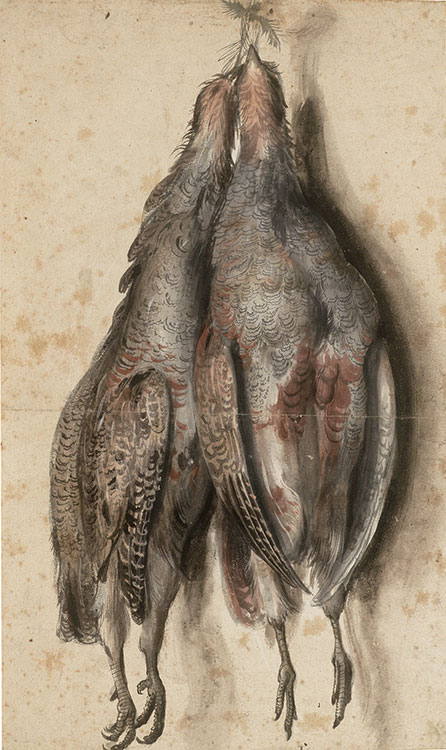
In this early example of the still-life genre, Cranach captured the texture and nuanced color of the partridges’ plumage, ranging from the delicate gray tufts covering the chest to the firmer, darker wing feathers. While the dead birds are rendered against a plain background, the carefully modulated shadows create an illusionistic impression of space. Despite the partridges’ uncanny physicality and the work’s high degree of finish, the drawing was not conceived as an autonomous work of art. Like Young Stag, on view nearby, it belongs to a portfolio of drawings of animals and birds used as models for paintings in the Cranach workshop.
Lucas Cranach the Elder
German, 1472–1553
Two Dead Partridges, ca. 1530–35
Brush and gray wash, and watercolor and opaque watercolor, heightened with white
Kupferstich-Kabinett, Staatliche Kunstsammlungen Dresden, INV. NO. C 1195
© Kupferstich-Kabinett, Staatliche Kunstsammlungen Dresden
Photo: Herbert Boswank
Ian Hicks, Moore Curatorial Fellow
In 1504, Duke Frederick the Wise appointed Lucas Cranach the Elder as court artist at Wittenberg, the electoral capital of Saxony. Soon after, Cranach began building a workshop full of assistants and pupils to help him decorate the Saxon palaces and produce a steady stream of portraits over the ensuing decades. This carefully executed watercolour of two dead partridges is an early example of still-life, a genre often credited to Jacopo de’ Barbari, Cranach’s predecessor at the Saxon court. An earlier watercolour of a dead partridge by Jacopo survives and may well have inspired Cranach’s work.
The artist began this study with a preliminary drawing in brush and light grey wash. He then developed the work with a combination of dilute and opaque watercolours to describe the colour and varied textures of the partridges’ feathers. Like Cranach’s watercolour of a young stag hanging nearby, the sheet belonged to a collection of studies of birds and animals that were kept in the artist’s workshop and used as models for paintings and prints. Similar pairs of dead partridges hang in the background of several paintings by Cranach and his workshop from the 1530s that depict an episode from the Life of Hercules. The scene illustrates the demigod’s forced servitude to Queen Omphale and shows him surrounded by courtly women. Partridges were known since antiquity as a symbol of lust and served to heighten the paintings’ erotic implications.
